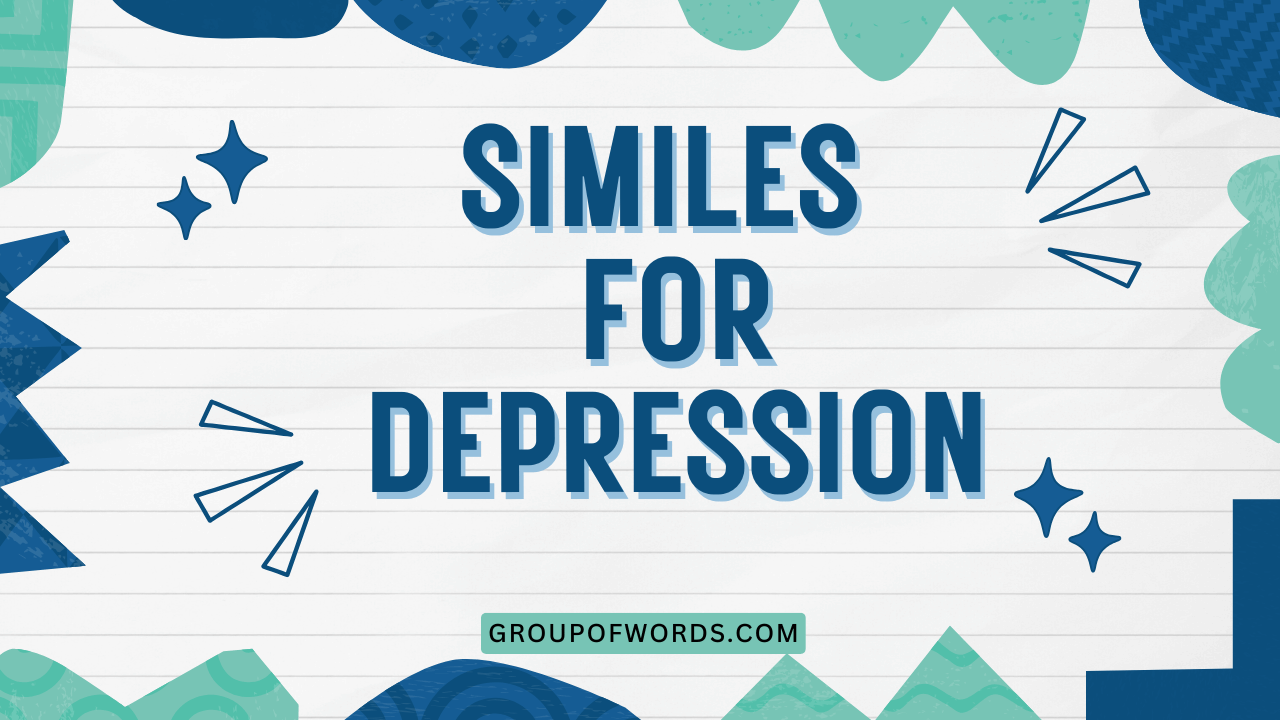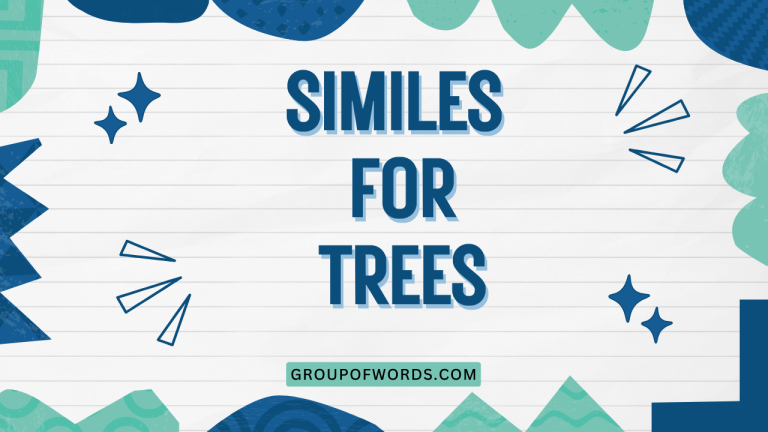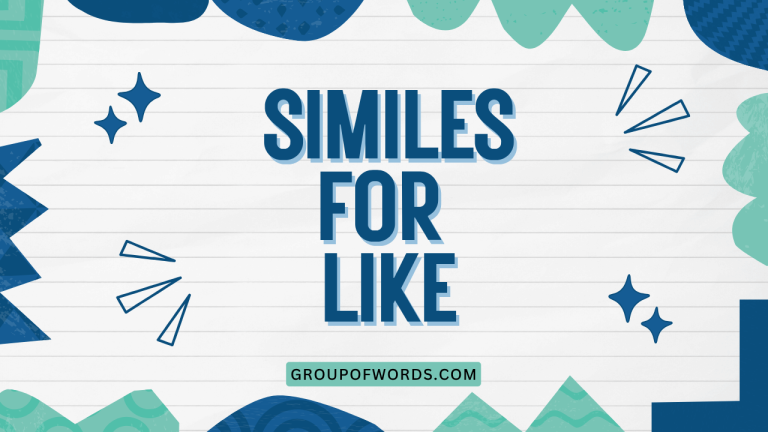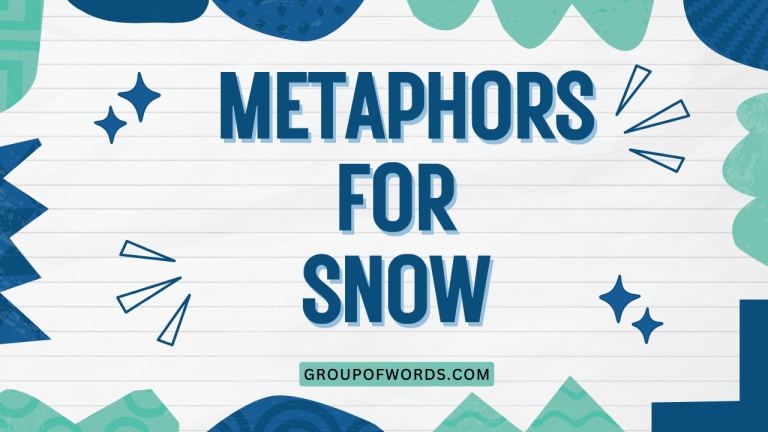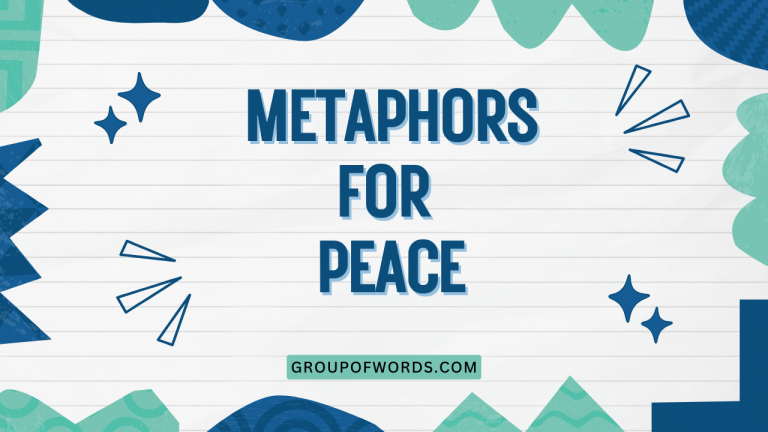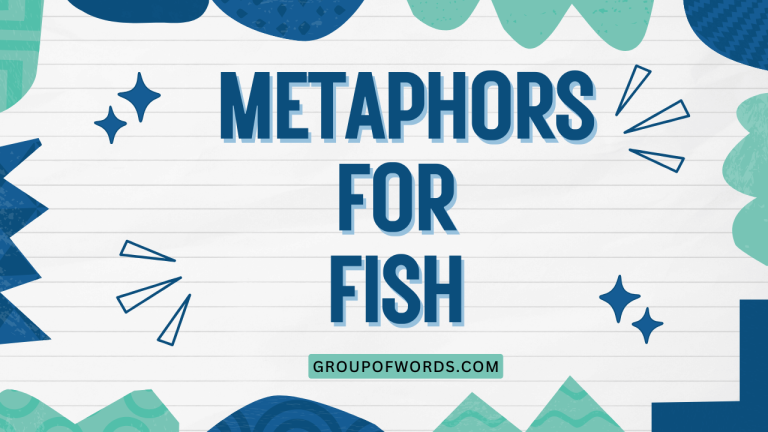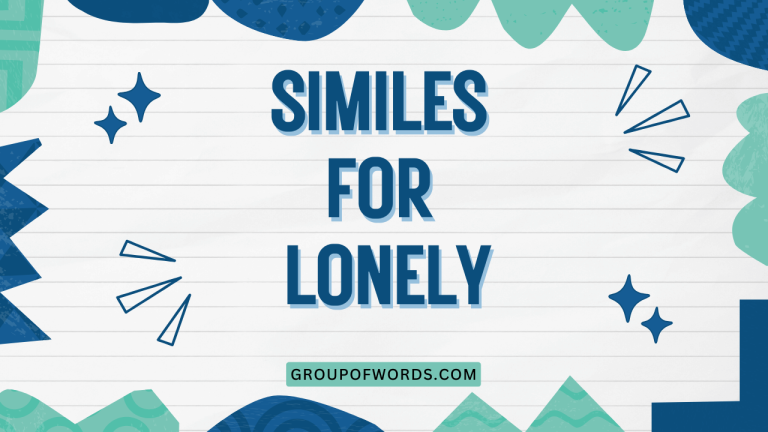Similes for Depression: Understanding the Language of Despair
Understanding how to express complex emotions is crucial for effective communication, especially when discussing sensitive topics like depression. Similes, with their ability to create vivid comparisons, offer a powerful tool for articulating the often indescribable feelings associated with this condition.
This article explores the use of similes in describing depression, providing a comprehensive guide for both those experiencing it and those seeking to understand it better. By examining various examples and grammatical structures, this resource aims to enhance your understanding of how similes can be used to convey the nuances of depression.
This guide will be particularly beneficial for students, writers, mental health professionals, and anyone interested in improving their emotional vocabulary.
Table of Contents
- Introduction
- Definition of Simile
- Structural Breakdown of Similes
- Types of Similes for Describing Depression
- Examples of Similes for Depression
- Usage Rules for Similes
- Common Mistakes When Using Similes
- Practice Exercises
- Advanced Topics in Similes
- Frequently Asked Questions
- Conclusion
Definition of Simile
A simile is a figure of speech that directly compares two different things using the words “like” or “as.” It is a powerful tool for creating vivid imagery and helping the reader or listener understand a concept by relating it to something familiar. Similes are used extensively in literature, poetry, and everyday conversation to add depth and color to language, making it more engaging and memorable. In the context of depression, similes can be particularly effective in conveying the often abstract and deeply personal experiences associated with the condition.
Similes fall under the broader category of figurative language, which includes metaphors, personification, and hyperbole. Unlike metaphors, which state that one thing *is* another, similes only suggest a resemblance. This subtle difference allows for more nuanced and less absolute comparisons, which can be especially important when discussing complex emotional states. Similes function to clarify, emphasize, and evoke emotions, making them invaluable tools for communication and expression.
Structural Breakdown of Similes
The basic structure of a simile consists of three main components: the subject being described, the linking word (“like” or “as”), and the object of comparison. Understanding this structure is essential for creating effective and meaningful similes.
The subject is the thing you are trying to describe, in this case, aspects of depression. The linking word establishes the comparison.
The object of comparison is something that shares a quality or characteristic with the subject, allowing you to draw a parallel.
The formula for a simile can be expressed as follows: Subject + Linking Word (like/as) + Object of Comparison. For example, in the simile “My sadness is like a heavy weight,” “My sadness” is the subject, “is like” is the linking phrase, and “a heavy weight” is the object of comparison. This structure provides a framework for constructing similes that are both grammatically correct and emotionally resonant.
Let’s break down the elements further:
- Subject: The aspect of depression being described (e.g., feelings of hopelessness, lack of energy).
- Linking Word: Either “like” or “as” – these words explicitly signal a comparison.
- Object of Comparison: Something tangible or relatable that shares a characteristic with the subject (e.g., a dark cloud, a locked room).
Types of Similes for Describing Depression
Similes can be categorized based on the aspect of depression they aim to describe. Understanding these categories can help you choose the most appropriate simile for conveying a specific feeling or experience.
Here are some common types of similes used to describe depression:
1. Similes Describing Emotional Numbness
These similes focus on the lack of feeling or emotional detachment often associated with depression. They highlight the inability to experience joy, sadness, or any strong emotions.
2. Similes Describing Overwhelming Sadness
These similes depict the intense and pervasive sadness that characterizes depression. They often use imagery of weight, darkness, or drowning to convey the overwhelming nature of the emotion.
3. Similes Describing Lack of Energy and Motivation
These similes illustrate the fatigue, lethargy, and lack of motivation that are common symptoms of depression. They often compare the individual to something heavy, slow, or immobile.
4. Similes Describing Feelings of Isolation
These similes convey the sense of loneliness, disconnection, and alienation that can accompany depression. They often use imagery of being trapped, separated, or invisible.
5. Similes Describing Cognitive Impairment
These similes address the difficulties with concentration, memory, and decision-making that can occur during depressive episodes. They often compare the mind to something foggy, slow, or broken.
Examples of Similes for Depression
The following tables provide a variety of examples of similes used to describe different aspects of depression. Each table focuses on a specific category, offering a range of options for expressing the nuances of this complex condition.
Table 1: Similes Describing Emotional Numbness
This table provides similes that capture the feeling of emotional emptiness and detachment often experienced during depression.
| Simile | Explanation |
|---|---|
| My heart feels like a stone. | This simile suggests a lack of feeling or warmth in the heart, symbolizing emotional numbness. |
| I feel as empty as a hollow shell. | This simile conveys a sense of inner emptiness and lack of substance. |
| My emotions are like a muted television. | This simile suggests that emotions are present but suppressed or dulled. |
| The world feels like a black and white movie. | This simile reflects the lack of color and vibrancy in life. |
| I am as indifferent as a robot. | This simile captures a state of emotional detachment and lack of empathy. |
| My soul feels like a frozen lake. | Suggests emotions are trapped beneath a surface of coldness. |
| I feel like a ghost, present but unseen. | Conveys a sense of disconnection and invisibility. |
| My joy is like a distant memory. | Highlights the inaccessibility of positive emotions. |
| I’m as responsive as a brick wall. | Illustrates a lack of emotional engagement. |
| My feelings are like a faint echo. | Shows a diminished and weakened emotional response. |
| I feel like a wind-up toy that’s run down. | Depicts a state of being emotionally and physically depleted. |
| My heart is as still as a stopped clock. | Suggests a complete cessation of emotional activity. |
| I feel like a puppet with cut strings. | Conveys a sense of being controlled or manipulated by depression. |
| The world is as appealing as a blank canvas. | Indicates a lack of interest or excitement in anything. |
| My emotions are like a dial turned down to zero. | Illustrates a complete absence or suppression of feelings. |
| I feel like a statue, cold and unmoving. | Suggests emotional rigidity and lack of responsiveness. |
| My laughter is as rare as a blue moon. | Highlights the infrequency of experiencing joy or amusement. |
| I am as sensitive as a stone. | Conveys a lack of emotional vulnerability or empathy. |
| My tears are like a dry well. | Suggests an inability to express sadness or grief. |
| I feel like a broken record, repeating the same empty phrases. | Depicts a monotonous and unfulfilling existence. |
| My spirit is as barren as a desert. | Illustrates a lack of emotional nourishment or vitality. |
| I feel like a shell, devoid of its inhabitant. | Conveys a sense of hollowness and emptiness. |
| My feelings are like a ship lost at sea. | Suggests a sense of being directionless and without purpose. |
| I am as excited as a corpse. | Highlights the complete absence of enthusiasm or anticipation. |
Table 2: Similes Describing Overwhelming Sadness
This table provides similes that capture the intense and pervasive sadness associated with depression.
| Simile | Explanation |
|---|---|
| My sadness is like a heavy weight on my chest. | This simile conveys the feeling of oppression and burden that accompanies sadness. |
| I feel as though I’m drowning in sorrow. | This simile suggests being overwhelmed and suffocated by sadness. |
| My heart is as heavy as lead. | This simile implies a deep and profound sadness that weighs down the heart. |
| The world looks as gray as a rainy day. | This simile connects the internal feeling of sadness with the external environment. |
| I feel like a prisoner in my own despair. | This simile captures the feeling of being trapped and confined by sadness. |
| My tears flow like a never-ending river. | Illustrates the constant and uncontrollable expression of sadness. |
| Sadness clings to me like a persistent shadow. | Conveys the feeling of being constantly followed by negativity. |
| My heart aches like a throbbing wound. | Depicts the intense and painful sensation of sadness. |
| Despair engulfs me like a thick fog. | Suggests being surrounded and obscured by negative emotions. |
| My spirit is as broken as shattered glass. | Illustrates the fragility and vulnerability of one’s inner self. |
| I feel like a wilting flower, losing all its life. | Depicts a gradual decline in vitality and well-being. |
| My hope is as faint as a dying ember. | Suggests a diminishing and precarious sense of optimism. |
| Sadness creeps into my bones like a chilling draft. | Conveys the feeling of a deep and pervasive coldness. |
| I feel like a ship lost in a stormy sea. | Depicts a sense of being overwhelmed and directionless. |
| My joy is as distant as a forgotten star. | Highlights the inaccessibility of positive emotions. |
| I feel like a marionette with tangled strings. | Suggests a lack of control and manipulation by sadness. |
| My heart is as heavy as a stone in my chest. | Conveys the feeling of a physical burden caused by sadness. |
| Sadness permeates me like ink in water. | Illustrates the thorough and complete saturation of negative emotions. |
| My soul feels like a dark and empty room. | Depicts a sense of desolation and emptiness. |
| I feel like a ghost haunting my own life. | Conveys a sense of detachment and alienation from oneself. |
| My tears fall like a gentle rain. | Suggests a steady and continuous flow of sadness. |
| Sadness wraps around me like a cold blanket. | Illustrates a feeling of being trapped and suffocated by negativity. |
| My heart feels like it’s breaking into a million pieces. | Depicts an intense and overwhelming emotional pain. |
| I feel like I’m walking through a never-ending tunnel. | Conveys a sense of hopelessness and lack of direction. |
| My laughter is as hollow as an empty drum. | Suggests a superficial and insincere expression of joy. |
Table 3: Similes Describing Lack of Energy and Motivation
This table provides similes that capture the fatigue, lethargy, and lack of motivation associated with depression.
| Simile | Explanation |
|---|---|
| I feel as heavy as a ton of bricks. | This simile conveys a sense of physical and mental exhaustion. |
| My energy is like a drained battery. | This simile suggests a complete lack of power and vitality. |
| I move as slowly as a snail. | This simile implies a lack of speed and efficiency in actions. |
| My motivation is like a flickering candle in the wind. | This simile suggests a fragile and easily extinguished desire to act. |
| I feel like I’m wading through mud. | This simile captures the feeling of being stuck and struggling to move forward. |
| My thoughts move as slow as molasses. | Illustrates a sluggish and labored cognitive process. |
| I’m as energetic as a sloth. | Conveys an extreme lack of activity and enthusiasm. |
| My get-up-and-go has got-up-and-gone, like a runaway train. | Depicts a complete absence of motivation and drive. |
| I feel like a deflated balloon, empty and lifeless. | Suggests a loss of energy and vitality. |
| My ambition is as dormant as a hibernating bear. | Illustrates a state of inactivity and suspended animation. |
| I feel like a rusty machine, creaking with every move. | Depicts a sense of stiffness and difficulty in functioning. |
| My drive is as weak as a newborn kitten. | Suggests a fragile and underdeveloped sense of purpose. |
| I feel like a puppet with tangled strings, unable to move. | Conveys a sense of being controlled and restricted by depression. |
| My energy is as low as a snake in the grass. | Depicts a deceptive and hidden lack of vitality. |
| I feel like a tree without roots, easily toppled. | Suggests a lack of stability and resilience. |
| My motivation is as buried as a treasure chest. | Illustrates a hidden and inaccessible desire to act. |
| I feel like a broken compass, unable to find my way. | Conveys a sense of disorientation and lack of direction. |
| My enthusiasm is as cold as ice. | Depicts a complete absence of warmth and passion. |
| I feel like a zombie, going through the motions. | Suggests a state of being alive but without consciousness or purpose. |
| My spirit is as heavy as a lead balloon. | Illustrates a sense of being weighed down and unable to rise. |
| I feel like a stone, unmoved by anything. | Conveys a sense of apathy and indifference. |
| My thoughts are as sticky as mud. | Suggests a difficulty in processing information and making decisions. |
| I feel like a shadow, following others without a purpose. | Illustrates a sense of being invisible and without identity. |
| My willpower is as fragile as glass. | Depicts a vulnerability to temptation and a lack of self-control. |
| I feel like a broken record, repeating the same patterns of behavior. | Suggests a monotonous and unfulfilling existence. |
Table 4: Similes Describing Feelings of Isolation
This table provides similes that capture the sense of loneliness, disconnection, and alienation associated with depression.
| Simile | Explanation |
|---|---|
| I feel as isolated as a desert island. | This simile conveys a sense of being completely alone and cut off from the world. |
| I feel like an outsider looking in. | This simile suggests a sense of detachment and exclusion from social interactions. |
| My loneliness is like a deep, dark well. | This simile implies a profound and inescapable sense of isolation. |
| I feel like a ghost, unseen and unheard. | This simile suggests a sense of invisibility and insignificance. |
| I am as alone as a single star in the night sky. | This simile conveys a sense of being unique but also isolated. |
| I feel like a lone wolf, separated from the pack. | Illustrates a sense of being different and unable to fit in. |
| My heart is as cold as a winter’s night. | Conveys a lack of warmth and connection with others. |
| I feel like a statue in a crowded room, unmoving and unnoticed. | Depicts a sense of being present but disconnected from one’s environment. |
| My voice is as silent as the grave. | Suggests an inability to express oneself and connect with others. |
| I am as distant as the moon. | Illustrates a feeling of remoteness and inaccessibility. |
| I feel like a shadow, always following but never seen. | Depicts a sense of being unnoticed and without identity. |
| My spirit is as confined as a bird in a cage. | Suggests a lack of freedom and connection with the outside world. |
| I feel like a lost ship at sea, without a destination. | Conveys a sense of disorientation and lack of purpose. |
| My laughter is as hollow as an empty room. | Depicts a superficial and insincere expression of joy. |
| I am as invisible as the wind. | Illustrates a feeling of being unnoticed and unimportant. |
| I feel like a stranger in a foreign land. | Conveys a sense of unfamiliarity and disconnection. |
| My heart is as empty as a vacant house. | Depicts a sense of hollowness and lack of warmth. |
| I feel like a broken puzzle piece, unable to fit in. | Suggests a sense of being incomplete and incompatible with others. |
| My thoughts are as distant as a forgotten dream. | Illustrates a feeling of remoteness and inaccessibility. |
| I feel like a lone tree in a vast forest. | Conveys a sense of being surrounded by others but still alone. |
| My voice is as faint as a whisper. | Suggests an inability to express oneself and connect with others. |
| I am as isolated as a lighthouse on a stormy coast. | Illustrates a feeling of being alone and exposed. |
| I feel like a ghost haunting my own life. | Depicts a sense of detachment and alienation from oneself. |
| My heart is as heavy as a stone in my chest. | Conveys a feeling of emotional burden and oppression. |
| I feel like I’m walking through a never-ending maze. | Suggests a sense of disorientation and lack of direction. |
Usage Rules for Similes
While similes offer creative freedom, certain rules ensure clarity and effectiveness. Here are some key guidelines to follow:
- Ensure a Clear Connection: The comparison should be logical and easily understood. The object of comparison should share a recognizable trait with the subject.
- Avoid Clichés: Overused similes (e.g., “as busy as a bee”) can weaken your writing. Strive for originality.
- Maintain Consistency: Ensure the simile aligns with the overall tone and style of your writing.
- Use Sparingly: Overuse of similes can make your writing feel forced or unnatural. Use them judiciously for maximum impact.
- Consider Audience: Tailor your similes to your audience’s knowledge and understanding. A simile that resonates with one audience may not work for another.
Common Mistakes When Using Similes
Even experienced writers can make mistakes when using similes. Here are some common errors to avoid:
| Incorrect | Correct | Explanation |
|---|---|---|
| My sadness is like happiness. | My sadness is like a dark cloud. | The comparison should be between dissimilar things that share a common trait. |
| I feel as a bird. | I feel as free as a bird. | The simile needs a complete comparison, not just a preposition. |
| My depression is like I feel sad. | My depression is like a heavy weight I carry. | The simile should compare the subject to an object or concept, not a feeling. |
| I am as like a stone. | I am as cold as a stone. | The linking word “like” should not be followed by “a.” An adjective should be used to complete the comparison. |
| Sadness is like sad. | Sadness is like a deep ocean. | The comparison should be between dissimilar things, not the same concept. |
Practice Exercises
Test your understanding of similes with these practice exercises. For each sentence, create a simile that effectively describes the feeling or experience.
Exercise 1: Identifying Effective Similes
For each of the following sentences, determine whether the simile is effective. If not, explain why.
| Sentence | Effective? | Explanation (if not effective) |
|---|---|---|
| My hope is like a bright star. | Yes | |
| My sadness is like more sadness. | No | The comparison should be between dissimilar things. |
| I feel as happy as an elephant. | No | The comparison is illogical and does not create a clear image. |
| My energy is like a drained battery. | Yes | |
| I am as alone as a group of people. | No | The comparison is contradictory. |
Exercise 2: Completing Similes
Complete the following sentences by adding a simile that effectively describes the feeling or experience.
| Sentence | Completed Simile |
|---|---|
| My sadness is like _____. | My sadness is like a heavy weight on my shoulders. |
| I feel as empty as _____. | I feel as empty as a hollow shell. |
| My energy is like _____. | My energy is like a flickering candle. |
| I am as alone as _____. | I am as alone as a single star in the night sky. |
| The world looks as gray as _____. | The world looks as gray as a rainy day. |
Exercise 3: Writing Your Own Similes
Write your own similes to describe the following aspects of depression:
- Emotional numbness
- Overwhelming sadness
- Lack of energy
- Feelings of isolation
- Cognitive impairment
Example Answers:
- Emotional numbness: My heart feels like a stone.
- Overwhelming sadness: My sadness is like a heavy weight on my chest.
- Lack of energy: I feel as heavy as a ton of bricks.
- Feelings of isolation: I feel as isolated as a desert island.
- Cognitive impairment: My thoughts move as slow as molasses.
Advanced Topics in Similes
For advanced learners, exploring more nuanced aspects of similes can enhance their writing and communication skills. This includes understanding the difference between similes and metaphors, using extended similes, and employing similes in different literary contexts.
Similes vs. Metaphors: While both are figures of speech that make comparisons, similes use “like” or “as” to create a direct comparison, whereas metaphors imply a comparison by stating that one thing *is* another. For example, “My sadness is like a heavy weight” (simile) vs. “My sadness is a heavy weight” (metaphor).
Extended Similes: An extended simile develops the comparison over several lines or sentences, creating a more detailed and vivid image. This technique can be particularly effective in conveying complex emotions or experiences.
Similes in Literary Contexts: Different genres and styles of writing may call for different types of similes. For example, poetry often uses more imaginative and evocative similes, while scientific writing may use more precise and literal comparisons.
Frequently Asked Questions
Here are some frequently asked questions about using similes to describe depression:
- What is the difference between a simile and a metaphor?
A simile makes a direct comparison using “like” or “as,” while a metaphor implies a comparison by stating that one thing *is* another. Similes are generally considered less direct and more suggestive than metaphors.
- Why are similes useful for describing depression?
Similes provide a way to express complex and abstract emotions in a relatable and understandable way. They can help both those experiencing depression and those trying to understand it to better grasp the nuances of the condition.
- How can I avoid using clichés when writing similes?
To avoid clichés, focus on creating original and specific comparisons. Think about the unique aspects of the feeling or experience you are trying to describe, and find objects or concepts that share those qualities in unexpected ways.
- Can I use similes in formal writing?
While similes are often associated with creative writing, they can also be used in formal writing to clarify complex concepts or add emphasis. However, it is important to use them judiciously and ensure that they are appropriate for the tone and style of the writing.
- How can I improve my simile-writing skills?
Practice is key. Read widely to see how other writers use similes effectively, and experiment with different comparisons to find what works best for you. Pay attention to the specific qualities of the things you are comparing, and strive to create vivid and memorable images.
- Are there any cultural considerations when using similes?
Yes, cultural context can significantly impact the effectiveness of a simile. Objects and concepts that are familiar and meaningful in one culture may not resonate in another. Be mindful of your audience and choose comparisons that are likely to be understood and appreciated.
- How do I know if my simile is effective?
An effective simile should create a clear and vivid image in the reader’s mind and accurately convey the feeling or experience you are trying to describe. Ask for feedback from others to see if your similes resonate with them.
- What are some common pitfalls to avoid when using similes for depression?
Avoid using similes that are insensitive, trivializing, or stigmatizing. Be respectful of the experiences of those living with depression, and strive to create comparisons that are empathetic and understanding.
Conclusion
Similes are powerful tools for expressing the often indescribable feelings associated with depression, allowing for a deeper understanding and connection between individuals. By understanding the structure, types, and usage rules of similes, you can effectively communicate the nuances of this complex condition.
Remember to avoid clichés, maintain consistency, and consider your audience when crafting your similes. Through practice and careful consideration, you can harness the power of similes to create vivid and meaningful descriptions of depression, fostering greater empathy and understanding.
As you continue to explore the use of similes, remember that the most effective comparisons are those that are both original and relatable. Strive to create images that resonate with your audience and accurately convey the emotional weight of the experiences you are describing.
With practice and attention to detail, you can master the art of using similes to communicate complex emotions and foster deeper connections with others.
